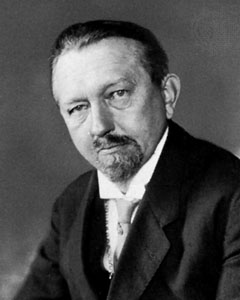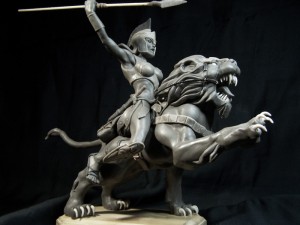Benin
Frobenius, Leo
Leo Frobenius (1873-1938), was a German ethnologist and a leading  authority on prehistoric art. He travelled extensively in West Africa and published many books on the cultures of the region. He placed Atlantis in the Yoruba region of Nigeria. Frobenius believed that the Etruscans had an Atlantean culture and were responsible for the establishment of Benin around 1300 BC and that it was a city in this region that had been described by Plato.
authority on prehistoric art. He travelled extensively in West Africa and published many books on the cultures of the region. He placed Atlantis in the Yoruba region of Nigeria. Frobenius believed that the Etruscans had an Atlantean culture and were responsible for the establishment of Benin around 1300 BC and that it was a city in this region that had been described by Plato.
I must point out that Frobenius was not the first to propose Nigeria as the home of Atlantis. Cyril Hammond Elgee (1871-1917) was the British Resident (local administrator) in Ibadan, Nigeria from 1902 until 1913. In 1914 he wrote a paper entitled The Evolution of Ibadan(h). His suggestion that Nigeria had been the location of Atlantis predated by some years the publication of Frobenius’ theory.
Jason Colavito has drawn attention to the racism displayed by Frobenius, an example of which is when he declared that the Atlantean civilisation of Yorubaland had been white(d). A report of his 1912 expedition was published and is now available online [1279].
He reported on his discoveries to the German Kaiser, who showed great interest in his work.
Five expeditions gave him enough information to publish a twelve-volume work entitled Atlantis. During his work there Frobenius wrote to friends complaining that local English officials had confiscated many of his finds(c).
In 1910 he published, in German, Atop the Rubble of Classical Atlantis that filled three large volumes. Much of his work is currently being translated into English and French.
Another site(a) reviewing Frobenius’ work also claims that he linked the ancient Yoruba kingdom with that of the Etruscans and suggests a common Atlantean ancestry. The same site backs a central Atlantic location for Atlantis, citing as ‘evidence’ the 18th century Bauche map(b).
Three papers taken from Frobenius’ work have been published on the Atlantisforschung website, with an English translation here(e)(f)(g).
(a) https://eden-saga.com/en/atlantis-american-empire-back-to-europe-etrusque-africa-yoruba-country.html
(b) https://eden-saga.com/en/greek-philosophy-mythology-timeos-critias-plato-s-atlantis.html
(c) https://trove.nla.gov.au/ndp/del/article/207225672?searchTerm=Atlantis discovered&searchLimits=
(e) Über die Bedeutung: “Atlantis” (Teil I) – Atlantisforschung.de (atlantisforschung-de.translate.goog)
(h) http://books.google.ie/books/about/The_Evolution_of_Ibadan.html?id=vyQZAAAAIAAJHYPERLINK “ *
Amazons
Amazons is the name used by classical writers(k) to identify two matriarchal nations living near the Black Sea and in ancient Libya, but at apparently  different periods. An extensive website on the subject associates the Amazons with three locations; Lake Tritonis(j) , the Greek island of Lemnos(i) and the River Thermodon, now known as Terme Çay, in northern Turkey(h).
different periods. An extensive website on the subject associates the Amazons with three locations; Lake Tritonis(j) , the Greek island of Lemnos(i) and the River Thermodon, now known as Terme Çay, in northern Turkey(h).
Accounts relating to these remote times are understandably vague but one tale describes the Libyan Amazons as waging war against the Atlanteans, a race who lived in a prosperous country with great cities.
Attention has been drawn to the fact that the Berbers, also known as Amazigh in North-West Africa have a matriarchal culture. The possibility of an etymological connection between Amazon and Amazigh was suggested by Guy C. Rothery (1863-1940) in his 1910 book, The Amazons[1393] , and recently endorsed by Emmet Sweeney in his Atlantis: The Evidence of Science[700]. In 1912, Florence Mary Bennett published Religious Cults Associated with the Amazons[1548], which has been republished in recent years.
Another matriarchal society in the same region has also been suggested for the Maltese Islands(h).
Sir John Chardin (1643-1713) a French-born traveller and merchant reported that a tribe of Amazons still existed in the Caucasus in the 17th century(d).
Although the idea may be seen as fanciful, recent archaeological discoveries have provided evidence of female warriors in ancient times in parts of the former Soviet Union. The archaeologist Jeannine Davis-Kimball has written of her investigations[045] into the subject. Peter James offers[046] a solution to the existence of two locations for the Amazons. He believes that the original Black Sea location is correct and that the transference of the story to North Africa was the result of the ‘libyanising’ intent of Dionysus of Miletus, who was later quoted by Diodorus Siculus in his account(f) of the Amazons.
. James offers this explanation as part of a larger relocation of mythologies to more westerly locations. Other interesting views of the Amazon mystery can be found on a number of websites(a)(b).
Lewis Spence advanced the imaginative view [259.49] that the Amazons were not women at all, but men whose appearance was considered effeminate by some commentators. A more rational explanation on offer is that the males of some peoples had little facial hair or shaved (such as the Hittites) and were possibly described by their more hirsute enemies as ‘women’.
The popular idea that the Amazons were single-breasted, man-hating warriors has recently been comprehensively debunked by Adrienne Mayor in her latest book, The Amazons[1043] .
>Even more eyebrow-raising is the suggestion that Amazon warriors existed in South America based on 16th century reports and modern research(c). Columbus, in a 1493 letter to Luis de Sant’angel, refers to an island named Matininó, which was inhabited only by women(m), armed with bows and arrows. Hernán Cortés also filed a similar report.<
The Smithsonian magazine published a useful overview(e) of the history of the Amazon story in the April 2004 edition and in September 2011 revealed the story of the little-known female warriors of Benin (formerly Dahomey), numbered in their thousands, who were active during the 17th, 18th and 19th centuries. The BBC published an article in August 2018 on their history and their modern day descendants(l) .
(a) https://www.maicar.com/GML/AMAZONS.html
(b) https://web.archive.org/web/20190509212918/https://www.amazonation.com/Archaeology.html
(c) https://brazilweirdnews.blogspot.ie/2011/05/amazons-phoenicians-and-atlantis.html
(d) https://www.abebooks.com/Travels-Sir-John-Chardin-Persia-East/5455430940/bd
(e) https://www.smithsonianmag.com/history/amazon-women-there-any-truth-behind-myth-180950188/?no-ist
(f) https://archive.org/details/lp0048_amazons_vs_at
(g) https://www.smithsonianmag.com/history/dahomeys-women-warriors-88286072/?no-ist
(h) https://www.myrine.at/Amazons/mobilIndex.html
(i) https://www.myrine.at/Lemnos/mobilLemnos.html
(j) https://www.myrine.at/Berber/mobilBerber.html
(k) https://www.myrine.at/Amazons/texts_e.html
(l) https://www.bbc.com/travel/story/20180826-the-legend-of-benins-fearless-female-warriors
>(m) https://tanlistwa.com/2018/02/22/martinica-women-island-iguanas-island-or-flowers-island/<
